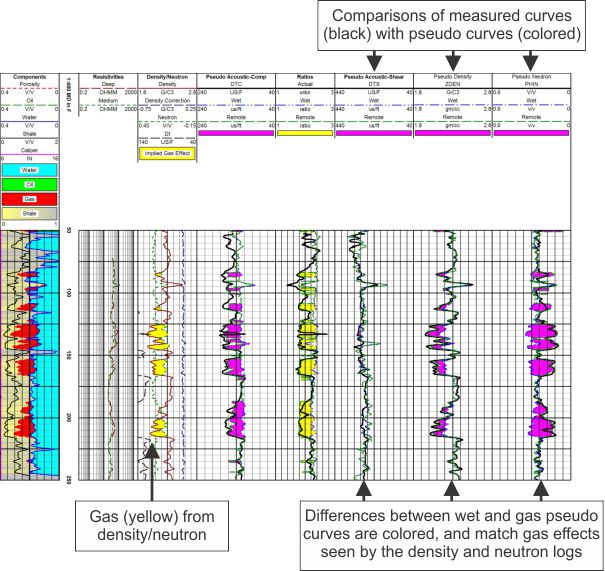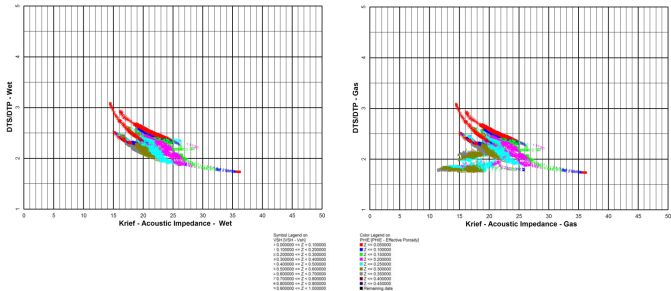Pseudo Porosity Logs and Estimates of Acoustic Shear Response
Starting point is the following model:
- Porosity – best from density/neutron combination, where calculations are mostly independent of fluid content and matrix properties
- Matrix
- Clay
Then, pseudo porosity logs are calculated for any combination of gas and water (in theory, the same approach can be used for oil/water systems. However, fluid property differences are less than in gas/water systems, and resulting pseudo log calculations have a wider range of error).
Pseudo wet and pseudo gas-bearing logs are compared with the original raw logs. If matrix and clay properties have been correctly estimated, the actual log must fall between the wet and gas-bearing pseudo logs. In shales, all three logs should superimpose.
We have applied our techniques to a number of reservoirs (clastic and carbonates) in North America, covering the full range of porosity and permeability. For those wells when shear acoustic data are available, there is good to excellent comparison with pseudo shear logs. Often, it is possible to highlight intervals where the service company processing of shear data is unreliable.
Also, the analytic procedures can be used to identify shale intervals that are quite different from their neighbors (mismatch between actual logs, especially compressional acoustic, and the pseudo logs). This observation has implications in mapping regional geologic differences (clay mineralogy, or compaction), and may be used to identified overpressured sequences.
There are a number of important applications:
Geophysical
Validity of shear acoustic logs can be checked by comparing actual measurements with the pseudo logs. If a shear curve is not available and the system has been calibrated on close by wells where shear logs have been run, then the pseudo shear logs are a reliable substitution.
In extreme cases when no acoustic measurements have been made, and presuming the rock sequence is known, then both compressional and shear pseudo logs can be used.
VP/VS ratios can be compared with acoustic impedance – all data available from logs above – for categorization in AVO analysis.
Petrophysical
Validity of the basic petrophysical model is available by comparing pseudo logs with actual raw logs. Matrix and clay parameters can be adjusted until the match is reasonable.
By noting the position of the raw log as compared with pseudo wet and pseudo gas-bearing curves, the degree of gas saturation can be quantified for each porosity log in turn. In sequences where RW varies, this is a very useful tool to distinguish high resistivity fresh water wet sands from high resistivity low RW gas-bearing sands. Further, by combining gas saturation from porosity logs with resistivity response, a curve of changing RW is available. Conversely, if RW is well known, pseudo resistivity curves, based on gas saturation from the porosity log, and porosity can be calculated. Comparison with measured resistivity might give insight into cementation and saturation exponents, m and n.
Well Completion
One of the frequently missing log measurements, necessary to make estimates of mechanical properties, (especially shear modulus and Poisson’s ratio) is shear acoustic data. Often, an assumption of a constant ratio (DTS to DTC) is made. The ability to determine pseudo shear data avoids having to make this assumption. Additionally, our work has shown significant variations in the ratio DTS to DTC, dependent upon rock lithology and fluid content.
Since pseudo porosity response in both wet and gas-bearing rocks is available, differences in mechanical properties due to fluid content are routinely available.
Example – Geophysical Application


Example – Mechanical Properties
